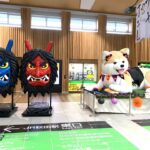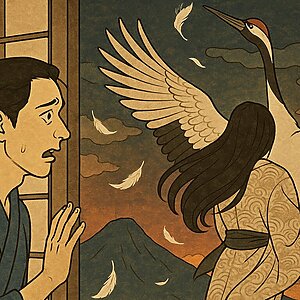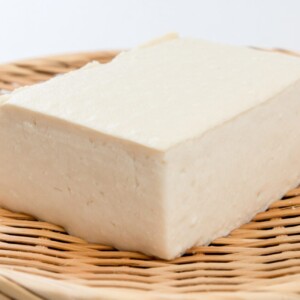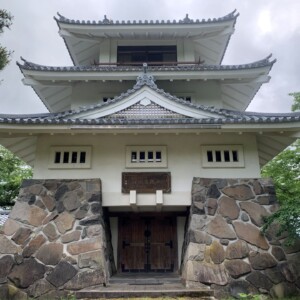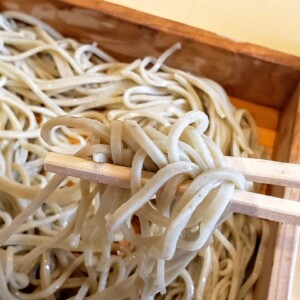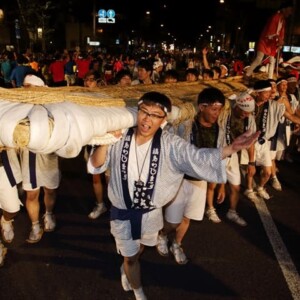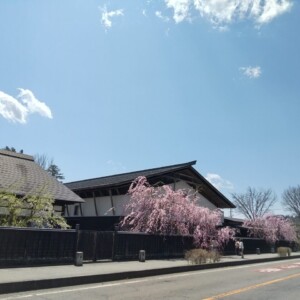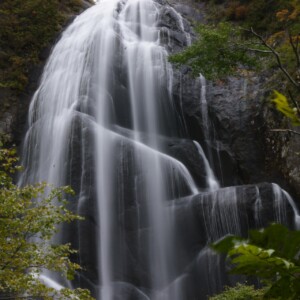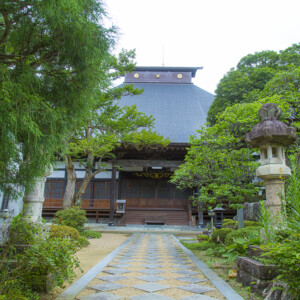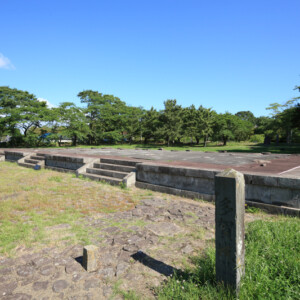
[The Mystery of Kamakura] Are Kamakura, a winter feature of Akita Prefecture, connected to the Kamakura Shogunate?
table of contents
- 1 There are several other kamakura besides the Yokote Kamakura
- 2 Why are the events held at the same Kamakura completely different?
- 3 The theory that the name "kamikura" (a shrine enshrined inside a small shrine made of snow) is a corrupted version of "kamakura"
- 4 A hearth made of snow is transformed into a kamakura (snow hut) to burn New Year's items such as kadomatsu.
- 5 The theory is that it is called "Kamakura" because it is an event dedicated to the deity Kamakura Daimyojin.
- 6 Celebrating the birth of the Kamakura Shogunate
- 7 The origin of the name Kamakura is the "bird-chasing song."
- 8 The illustration of a kamakura left by Sugae Masumi was of the now-defunct "Kamakura in Yuzawa"
- 9 Yokote Kamakura, a name synonymous with "kamakura"
- 10 "Rokugo Kamakura" where two armies fight fiercely with bamboo poles
- 11 At the "Kuzukuro Fire Festival Kamakura," children shout a mysterious incantation: "Hey, Gongoro of the Kamakura!"
- 12 Kakunodate's "Hifuri Kamakura" where people swing burning charcoal bags
- 13 Niida's "Hiburi Kamakura" where straw is set on fire and swung around
- 14 "Junisho Kamakurayaki" recreates the description of Masumi Sugae
A typical winter feature of Akita Prefecture is the " kamakura ." When you think of "kamakura," you may think of the " Yokote no Kamakura " (a Yokote City designated intangible folk cultural property), a long-standing tradition in Yokote City, where people pile up snow like a mountain, dig a big hole in it, and eat rice cakes and zoni inside.
There are several other kamakura besides the Yokote Kamakura
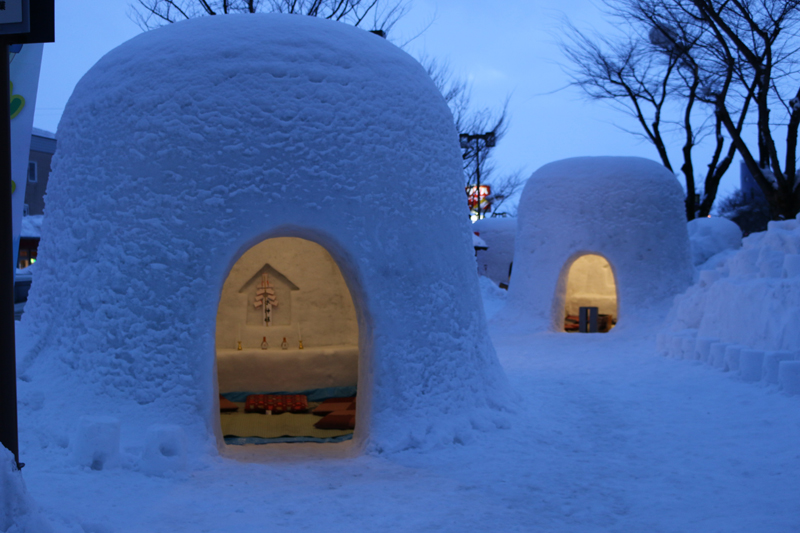
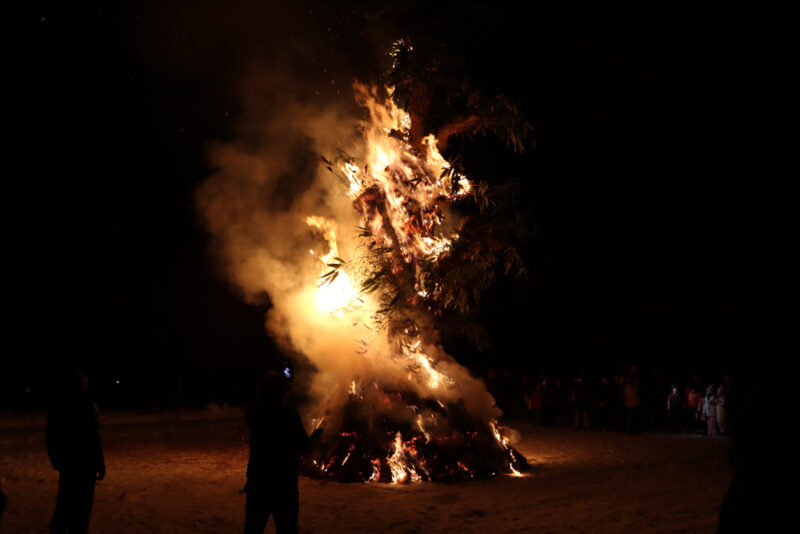
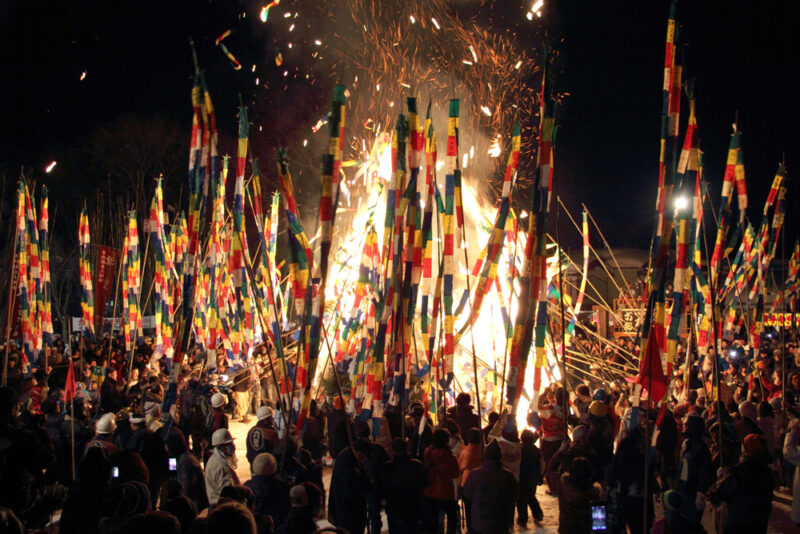
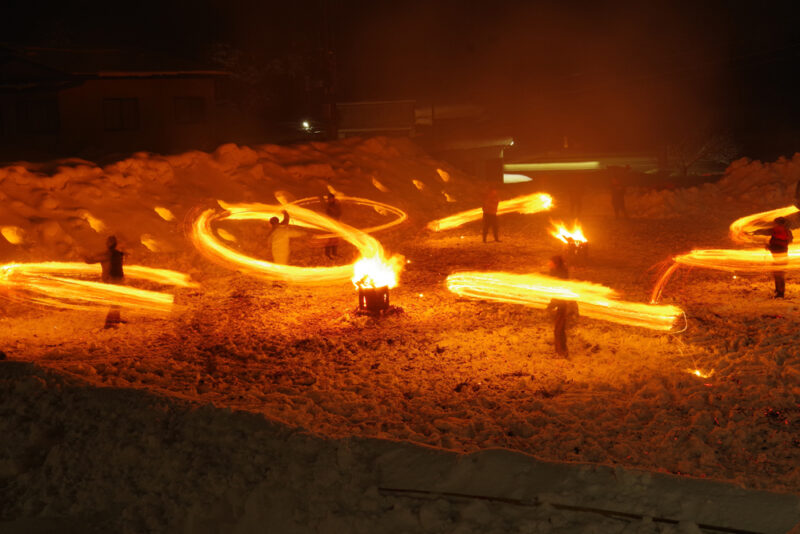
Speaking of kamakura, the " Hiburi Kamakura" (a Senboku City designated intangible folk cultural property) is also a kamakura. In fact, although it is not yet well known nationwide, the " Rokugo Kamakura " in Misato Town is also an ancient event, and is such an important traditional event that it has been designated as a nationally important intangible folk cultural property.
Furthermore, Kamakura Fire Festival held in village Junisho Kamakura " in Odate City, which has also been revived recently Niida Kamakura in Akita City are all events called "Kamakura."
Why are the events held at the same Kamakura completely different?
Why are there so many "kamakura" events in snowy Akita? I haven't heard of them much in other prefectures. Even if they do exist, they are not traditional events, but rather tourist events where people build snow domes to imitate the "Yokote Kamakura" and have fun. At these events, the snow domes are called "kamakura," but the original "kamakura" is not called that.
One of the reasons for this is that there are kamakura that are not built as snow domes that people can enter, like the "Hifuri Kamakura" in Kakunodate. Another reason is that there are big differences in the content of events that have the name "kamakura" in each region. Furthermore, it is said that this may be related to medieval samurai who called themselves "Kamakura," and that the Kamakura Shogunate may also have had a connection to kamakura.
Well, for the locals, the origin of the name doesn't really matter as long as they can enjoy the events that take place, but it seems to be of considerable interest to those who study traditional events and folk performing arts, and many research results have been published from the past to the present. However, it seems that nothing has yet gotten to the heart of the matter, and opinions are divided, with no conclusion being reached.
However, there are several theories that are considered to be plausible. Let us first introduce them in detail.
The theory that the name "kamikura" (a shrine enshrined inside a small shrine made of snow) is a corrupted version of "kamakura"
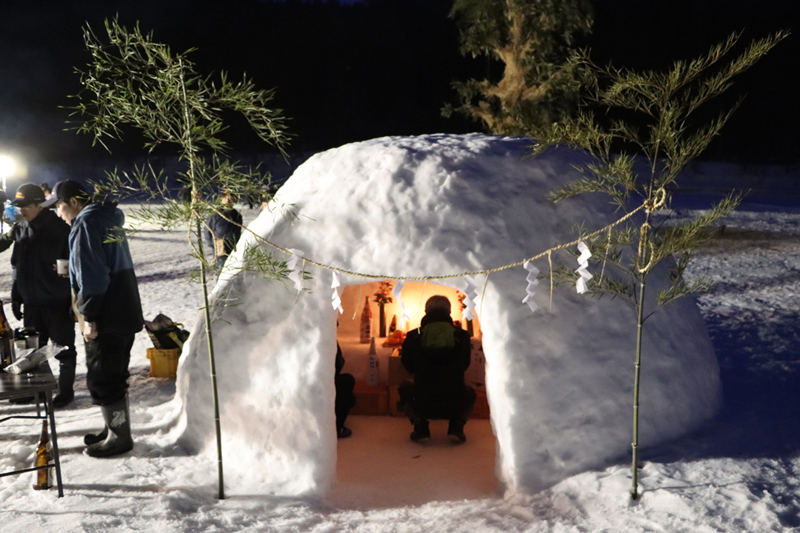
Although they don't build dome-shaped structures that people can fit inside, " snow caves " (setsudo), hollowed out from hardened snow, are built for all events, though they vary in size and shape. For example, the "Hifuri Kamakura" in Kakunodate is a small altar-like structure dedicated to the deity, while some, like the "Niida Kamakura," have been transformed from snow into a straw hut. However, their function is almost the same: a shinza (kamikura) is built deep inside the snow cave, where deities such as the water god are enshrined, and prayers are made for stable weather, bountiful harvests, and safety for the home. One theory about the etymology of the word "kamakura" is that the kamikura, the sanctuary dedicated to the deity, evolved into "kamakura."
A hearth made of snow is transformed into a kamakura (snow hut) to burn New Year's items such as kadomatsu.
The "Kamakura" event has in common that it is held on Koshogatsu (around February 15th in the new calendar, around January 15th in the old calendar), which marks the end of the New Year and a return to normal life. At that time, hearths were made out of snow to burn New Year's items such as kadomatsu (traditional Japanese pine decorations) and shimekazari (decorative New Year ornaments), and so the word "kamado" (stove) was transformed into "kamakura."
The theory is that it is called "Kamakura" because it is an event dedicated to the deity Kamakura Daimyojin.
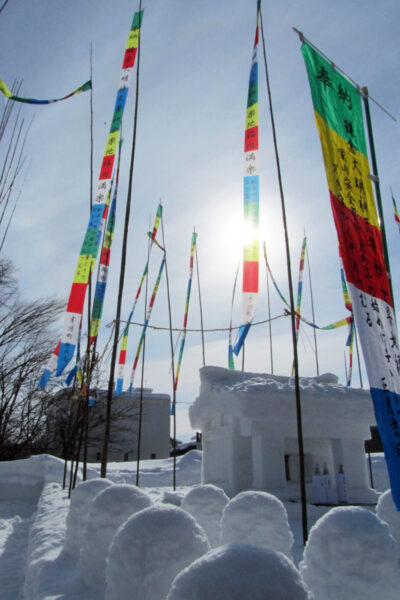
Kamakura Daimyojin Kamakura Gongoro Kagemasa the Gosannen War (1083-1087) that broke out the late Heian period. Kamakura Gongoro Kagemasa was a samurai who came from Kamakura-go, Sagami Province (Kamakura City, Kanagawa Prefecture) following Minamoto no Yoshiie (1039-1106), one of the main players in the Gosannen War. There is an anecdote that, at just 16 years old, he fought bravely despite being hit in the right eye by an enemy arrow.
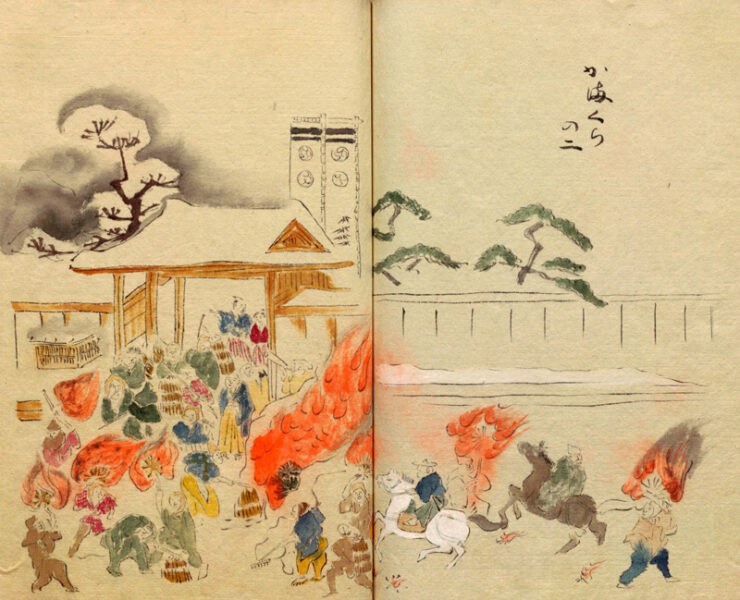
because in a picture from the Edo period, the flag of Kamakura Daimyojin is flying during the event that is said to be the origin of the name "Kamakura." Kamakura Daimyojin is the deity enshrined only in "Kamakura," and is not enshrined in any other events or homes other than "Kamakura," and is an object of worship only in Akita Prefecture. That's why "Kamakura" is only held in Akita Prefecture.
In other words, since Kamakura is an event dedicated to Kamakura Daimyojin, it is not surprising that the content changes depending on the location where it is held, and this theory is said to be quite plausible.
Celebrating the birth of the Kamakura Shogunate
This theory is based on the " Yokote Kamakura " and is based on the idea that it began as an event to celebrate the Kamakura Shogunate. For this reason, "Yokote Kamakura" was written as "Kamakura" during the Edo period. Also, "Rokugo Kamakura " was apparently written as "Kamakura," so the Kamakura Shogunate theory is quite convincing.
The origin of the name Kamakura is the "bird-chasing song."
In Kamakura, there is still a custom in some areas where children sing loudly " bird-chasing songs " to scare away wild birds that infest rice fields and other farmland and eat crops. One of the lyrics of this song is "Kamakura-dono," and this is why this event is called Kamakura.
The illustration of a kamakura left by Sugae Masumi was of the now-defunct "Kamakura in Yuzawa"
Sugae Masumi (1754-1829) also left behind explanatory texts and illustrations about kamakura. His first encounter with a kamakura is recorded in his 1784 work, " Akita no Karine (Akita no Karine) ." The location was Yuzawa, next to Yokote. Kamakura making is no longer practiced in Yuzawa. It is unknown when it disappeared, but the illustration shows children and adults digging holes in the high piles of snow and chatting inside. The text refers to this as " kamakura asobi " (playing in a kamakura), and states that the holes dug in the snow are called kamakura. *The illustration is from "Funponko."
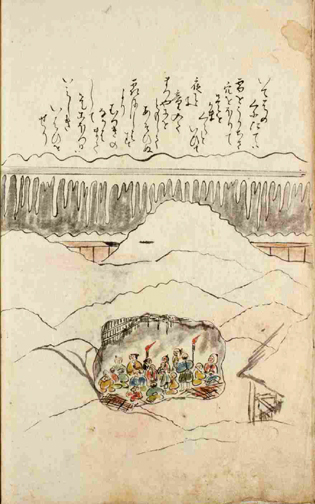
As you can see, there are many theories about Kamakura, but will the truth ever be revealed?
Now, let me introduce you to the overview and location of Kamakura, which is currently being held in 2025.
Yokote Kamakura, a name synonymous with "kamakura"
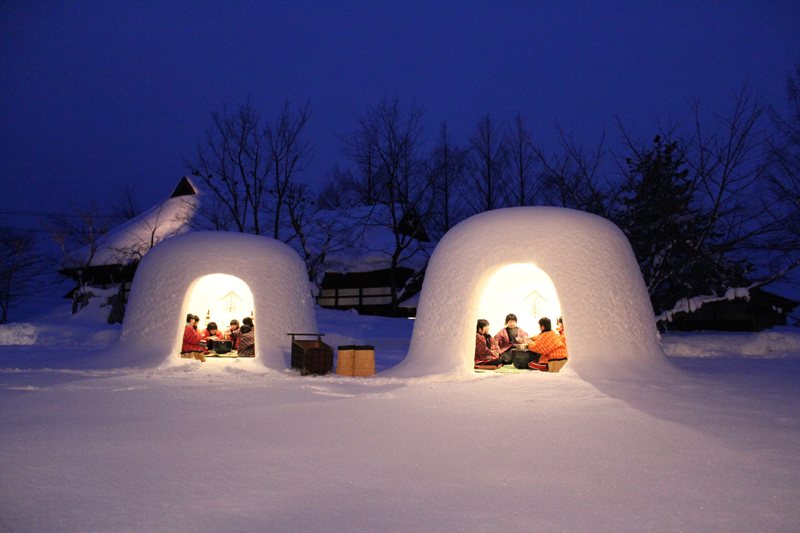
Yokote Kamakura is a traditional event that began around 450 years ago (some say it began in the Kamakura period), but before it took on its current form it was a combination of several events that were held in Yokote, and while some events have remained the same, others have disappeared and new ones have been added.
The snow caves were transformed into their current large snow domes with rounded roofs in 1959 (Showa 34), and it wasn't until the 1970s that they began to be held in parks and other locations as they are today. Surprisingly, this was because we were living in a car-oriented society and wanted to prevent the snow domes from interfering with traffic. However, if it meant that the event could be held safely, it may have been the right decision.
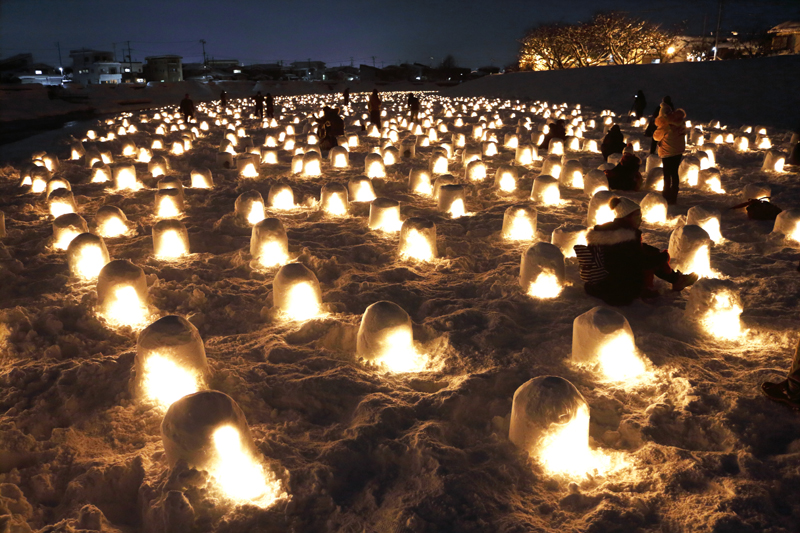
Yokote Kamakura is held as part of the Yokote Snow Festival on the first day of the new year (around February 15th) of the Gregorian calendar, but from 2026 to 2029, it will no longer be held on a fixed date, but will instead be held over two days on the second Friday and Saturday of February.
Yokote Kamakura Information
- Event name: Yokote Kamakura
- Cultural property designation: Yokote City designated intangible folk cultural property
- Location: Various locations in Yokote City
- Contact: Yokote City Tourism Association
- Phone number: 0182-33-7111
- Date:
- From 2026 to 2029: 2nd Friday to 2nd Saturday of February (2 days) *2030 and beyond is yet to be determined
- URL: Yokote Kamakura
- access:
- Public transportation: Get off at Yokote Station on the JR Ou Main Line. There is a free shuttle bus that connects to the main venue.
- By car: Approximately 10 minutes from Yokote IC or Yokote Kita Smart IC on the Akita Expressway, then take the free shuttle bus from the designated parking lot.
Yokote Snow Festival Information
- Event name: Yokote Kamakura / Mini Kamakura / Snow Art / Bonten Competition / Asahiokayama Shrine Bonten Dedication Festival
- Location: Various locations in Yokote City
- Contact: Yokote City Tourism Association
- Phone number: 0182-33-7111
- Date:
- Yokote Kamakura / 2nd Friday to 2nd Saturday of February (2 days / from 2026 to 2029 / TBA from 2030 onwards)
- Mini Kamakura: 2nd Friday to 2nd Saturday of February (2 days / from 2026 to 2029 / TBA from 2030 onwards)
- Snow Art / 2nd Friday to 2nd Saturday of February (2 days / 2026 to 2029 / TBA for 2030 and beyond)
- Bonten Competition / February 16th (fixed date)
- Asahiokayama Shrine Bonten Dedication Festival / February 17th (fixed date)
- access:
- Public transportation: Get off at Yokote Station on the JR Ou Main Line. There is a free shuttle bus that connects to the main venue.
- By car: Approximately 10 minutes from Yokote IC or Yokote Kita Smart IC on the Akita Expressway, then take the free shuttle bus from the designated parking lot.
Google Map
"Rokugo Kamakura" where two armies fight fiercely with bamboo poles
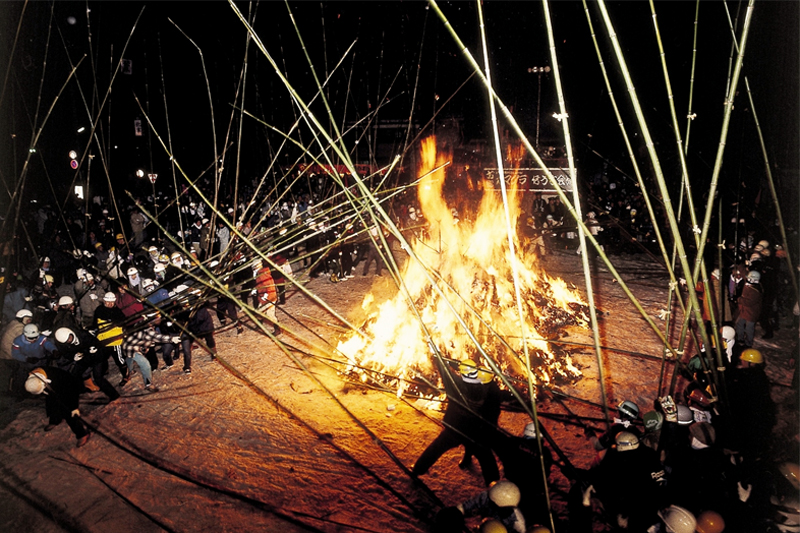
Kamakura is thought of as a heartwarming event held around a snow dome, like the Yokote Kamakura, but it is actually said to have been an intense event centered around fire ,
Rokugo Kamakura is a traditional " tenpitsu- , in which large, long pieces of paper called " heavenly writing brushes ) with wishes written on them are gathered together and burned, takeuchi " ceremony, in which young men from the village, separated into north and south, holding long bamboo poles, compete to predict good or bad luck for things like good harvests and the weather
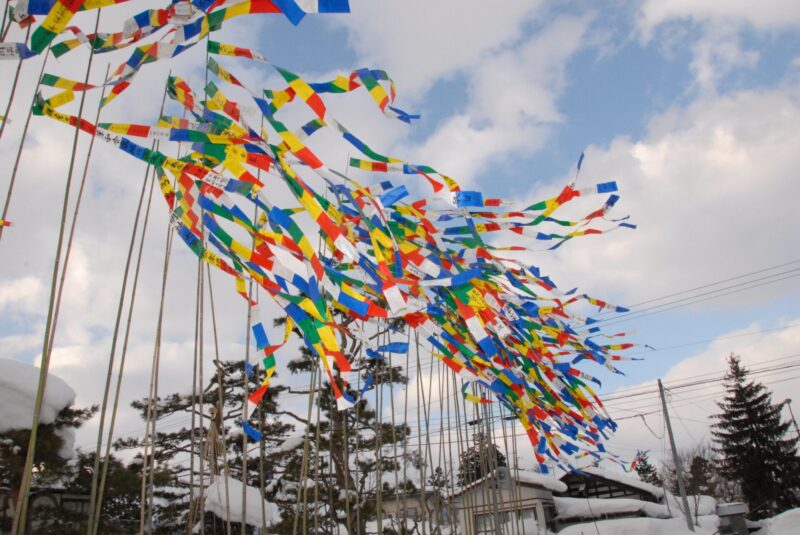
In "Rokugo no Kamakura," the word "kamakura" is written in katakana , and the name "kamakura" is used to refer to the entire event. The snow caves are not dome-shaped, but rather are rooms surrounded by snow, and inside they are dedicated to Kamakura Daimyojin, not the water god.
The bamboo fighting is played in three rounds, and it is said that if the Northern Army wins, there will be a good harvest, and if the Southern Army wins, the price of rice will rise. Either way, it is on the side of the farmers. "Rokugo Kamakura" is a nationally designated Important Intangible Folk Cultural Property (Name of Cultural Property: Rokugo Kamakura Event).
The event lasts for five days, and is scheduled each year so that the final day (when the bamboo pounding and Tenhitsu firing events take place) falls on a Saturday in mid-February. In 2025, it was held for five days from February 11th (Tuesday) to February 15th (Saturday). From 2026 onwards, please contact the Rokugo Kamakura Events Inheritance Association Secretariat (Tel: 0187-84-0020) or check the official website (Rokugo Kamakura) in the Information section below.
Kamakura Information in Rokugo
- Event name: Rokugo Kamakura Event
- Cultural property designation: Nationally designated important intangible folk cultural property
- Location: 115 Hondocho, Rokugo, Misato-cho, Senboku-gun, Akita Prefecture Bamboo pulverizing venue (Kamakura field)
- For inquiries, please contact: Rokugo Kamakura Events Inheritance Association Secretariat (inside Meisui Market Yutaro)
- Phone number: 0187-84-0020
- Date: The event will last for 5 days, with the final day falling on a Saturday in mid-February.
- URL: Kamakura in Rokugo
- access:
- Public transportation: Take the Akita Shinkansen, JR Ou Main Line, or Tazawako Line from Omagari to Rokugo or Yokote by bus for approximately 20 minutes, then get off at the Rokugo-Kamimachi bus stop and walk for approximately 5 minutes.
- By car: Approximately 15 minutes from Omagari IC on the Akita Expressway
Google Map
At the "Kuzukuro Fire Festival Kamakura," children shout a mysterious incantation: "Hey, Gongoro of the Kamakura!"

Kamakura Fire Festival held in Kuzokuro , a small village in Nanukaichi, located in the mountainous area in the central part of Kitaakita City in northern Akita Prefecture, is a kamakura event centered around fire , as the name
First, a large snow cave is made and dedicated to Kamakura Daimyojin. A large tree over 10 meters tall cut down from a nearby mountain is wrapped in rice straw and bean husks and set up in front of the cave. This tree is then set on fire as a sacred tree. Children shout Hey, Kamakura Gongoro!

The event is said to have begun around 300 years ago, but was discontinued in 1999 (Heisei 11). However, thanks to the efforts of local residents, it was revived in 2014 (Heisei 26), but was forced to suspend again due to the COVID-19 pandemic. It was then successfully revived in 2025. A contest is also held in which participants shout "Hey, Kamakura Gongoro!" as loud as they can, which has become a popular event. What does "Hey, Kamakura Gongoro!" mean? The "Kuzuguro Fire Festival Kamakura" is an intangible folk cultural asset designated by Kitaakita City.
The event will be held on the third Sunday of February, which in 2025 will be February 16th.
Kudzukuro Fire Festival Kamakura Information
- Event name: Kudzukuro Fire Festival Kamakura
- Cultural property designation: Kitaakita designated intangible folk cultural property
- Location: Kuzuguro, Nanakaichi, Kitaakita City, Akita Prefecture
- Contact: Public Relations Section, General Policy Division, General Affairs Department, Kitaakita City
- Phone number: 0186-62-6608
- Date: Third Sunday of February
- URL: Kudzukuro Fire Festival Kamakura
- access:
- Public transportation: Approximately 30 minutes by taxi from Takanosu Station on the JR Ou Main Line
- By car: Approximately 20 minutes from Odate-Noshiro Airport IC on the Akita Expressway
Google Map
Kakunodate's "Hifuri Kamakura" where people swing burning charcoal bags
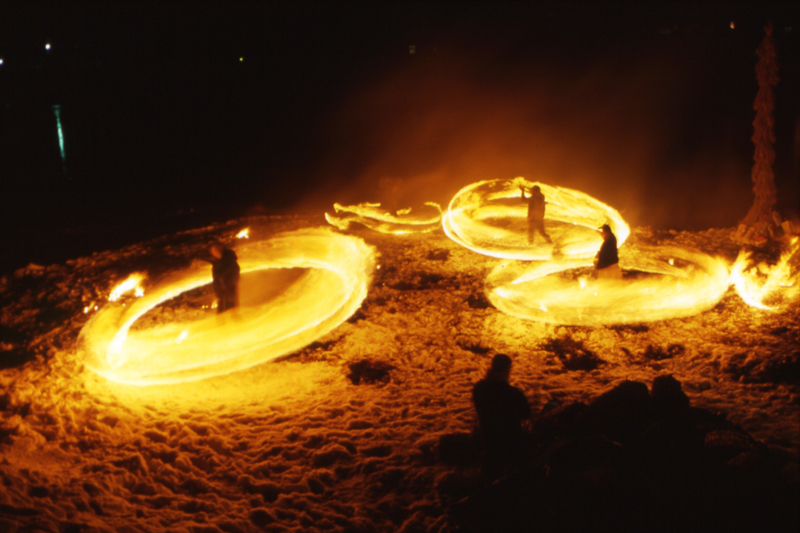
The " Hifuri Kamakura " is a traditional event that adds color to Kakunodate's winters. A charcoal sack is tied to the end of a 3m straw rope, which is then set on fire and swung around in a circle. The fantastical sight of rings of flame dancing against the snowy midwinter landscape is truly breathtaking.
It is held every year on February 14th, the first day of the new year according to the lunar calendar. The name "Hifuri Kamakura" was originally simply "Kamakura," but in recent years (about 20 to 30 years ago) it was renamed "Hifuri Kamakura" to distinguish it from the "Kamakura" event held in Yokote City, Akita Prefecture.
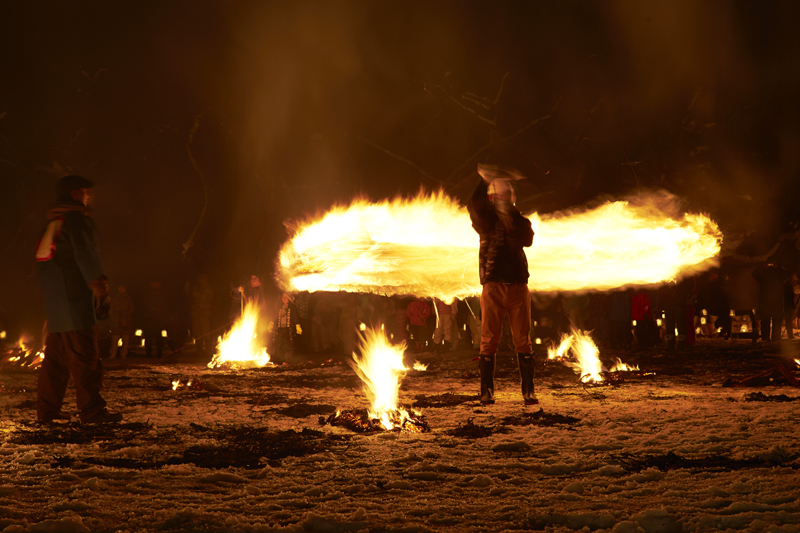
The Hiburi Kamakura festival used to be held on the eve of the festival on February 13th, but in 2025 it will only be held on February 14th. The venue is also not fixed and changes slightly every year. Tourists can try their hand at Hiburi Kamakura at some venues, but be sure to inquire with Semboku City or check their website for information on dates, venues, experiences, parking, etc. Hiburi Kamakura is an intangible folk cultural property designated by Semboku City.
Information about Kakunodate's "Hifuri Kamakura"
- Event name: Firefly squirrel
- Cultural property designation: Intangible folk cultural property designation: Senboku City
- For inquiries, please contact: Semboku City Kakunodate Tourist Information Center "Kakunodate Ekimaekura"
- Phone number: 0187-54-2700
- Date: February 14th
- Event time: 18:00-20:00
- Venue: Various locations in Kakunodate town (main venues, around 20 locations, etc.)
- URL: Kakunodate's Fire-Burning Kamakura
- access:
- Public Transportation: Approximately 20-30 minutes on foot from Kakunodate Station on the Akita Shinkansen, JR Tazawako Line, Akita Uchiriku Longitudinal Railway
- Car/About 40 minutes from the Akita Expressway Kyowa IC via National Routes 341 and 46
Google Map
Niida's "Hiburi Kamakura" where straw is set on fire and swung around
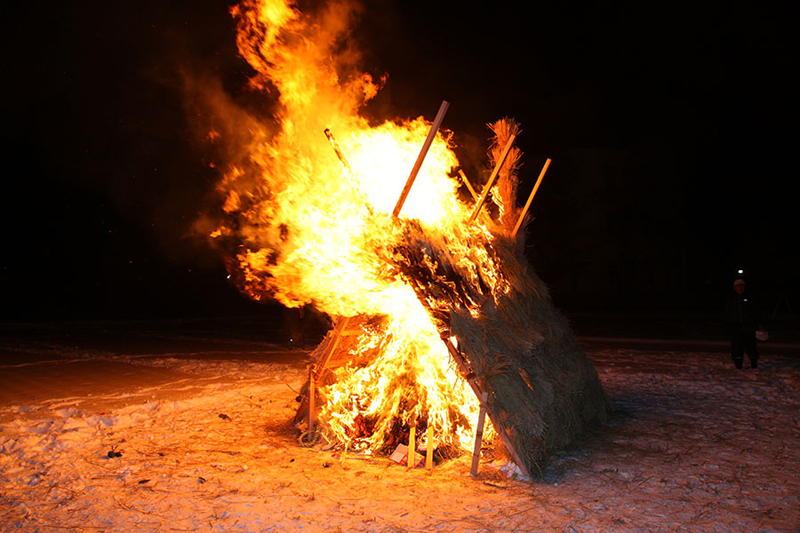
Hifuri Kamakura Niida (Akita City) is a Little New Year event that is said to have begun around 330 years ago. However, due to various reasons such as a lack of manpower and budget, it was discontinued around 1950.
Before the resurrection, people would build snow caves, but after the resurrection, they would build huts out of straw and put New Year's items inside. First, they would build an altar dedicated to Kamakura Daimyojin, perform a religious ceremony, and then light the hut on fire.
A bundle of straw is wrapped around the end of a straw rope and swung around in a circular motion. Its history is unknown, but it is certain that it has been called "Hifuri Kamakura" since the Edo period.
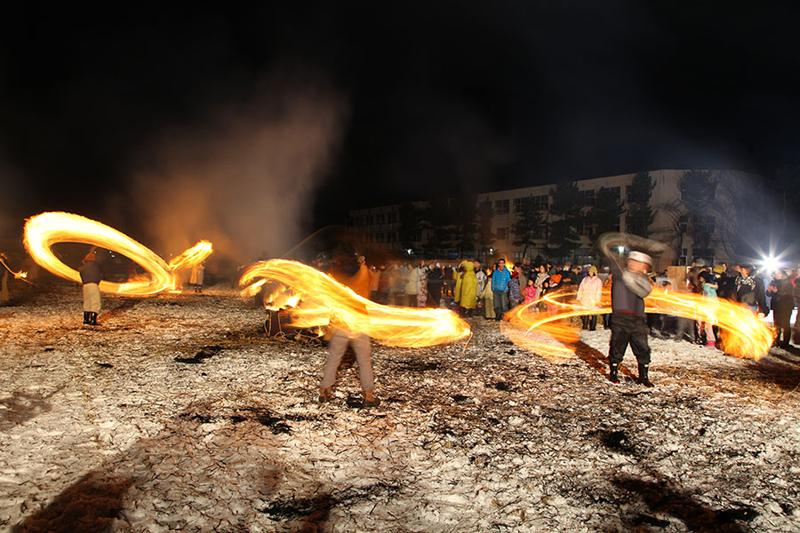
Until 2025, Niida's "Hifuri Kamakura" festival was held on January 15th, the first day of the new year in the solar calendar, but from 2026 onwards, it is scheduled to be held on Coming of Age Day.
Information about Niida's "Hifuri Kamakura"
- Event name: Niida's Fire-flying Kamakura
- Location: Niida Shinden, Akita City, Akita Prefecture
- For inquiries, please contact: Tourism Promotion Division, Tourism, Culture and Sports Department, Akita City
- Phone number: 018-888-5602
- Date: Coming of Age Day (2026 onwards)
- Event time: 18:00-19:00
- Location: Rice fields next to Onoba Junior High School in Niida Shinden
- access:
- Public transportation: Approximately 12 minutes by car from Araya Station on the Uetsu Main Line
- By car: Approximately 12 minutes from Akita Minami IC on the Akita Expressway
Google Map
"Junisho Kamakurayaki" recreates the description of Masumi Sugae
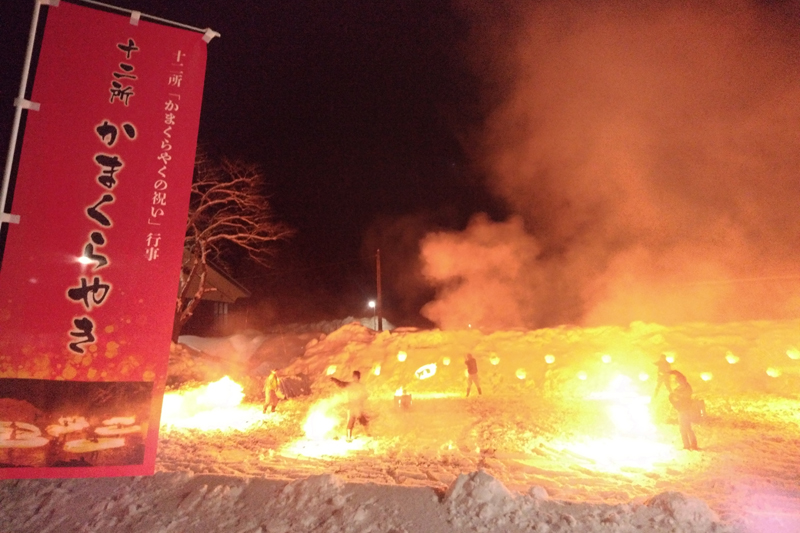
The "Junisho Kamakura Yaki" festival is a revival of the "kamakura" event that was held in Juunisho (Odate City), which prospered during the Edo period due to water transportation on the Yoneshiro River, and was based on the writings of travel writer Sugae Masumi when he visited the area.
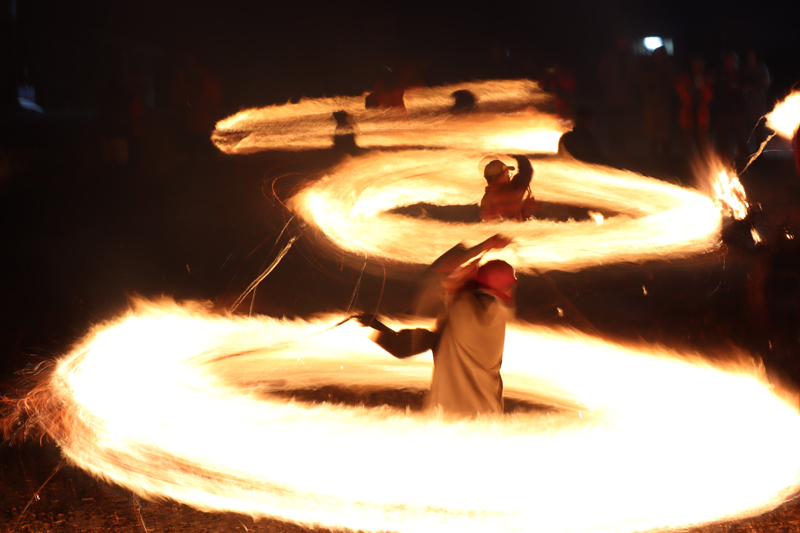
Masumi wrote, " I went to see the celebration of the Kamakura Festival at Jusansho, and lit charcoal bags and waved them around... " and when it was revived, the event remained in the same form. He visited in 1803, and it is clear that the festival had been called "Kamakura" at that time. Nowadays, it is more of a tourist attraction, and tourists can also participate.
Juunisho Kamakurayaki Information
- Event name: Kamakura baking
- Location: Jusansho-Nakamachi, Odate City, Akita Prefecture
- For inquiries, please contact: Odate City Jusansho Community Center
- Phone number: 0186-43-7123
- Date: February 14th
- access:
- Public transportation: Within walking distance from Junisho Station on the JR Hanawa Line
- By car: Approximately 20 minutes from Odate Minami IC on the Akita Expressway


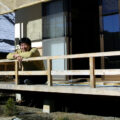

![Kakunodate, a castle town where flowers were opened during the Satake Kita family era [Senboku City highlights 3] 02 Kakunodate Festival_Akita Fan](https://jp.neft.asia/wp-content/uploads/2025/07/171a9cc7c9ae28ea78011ca1438448b1-150x150.jpg)

!["Snake's Nose, the Land of Flowers and History" is a garden where you can enjoy flowers in the seasons! [Motomiya City, Fukushima Prefecture] zyanohana1](https://jp.neft.asia/wp-content/uploads/2023/06/zyanohana1-150x150.jpg)
![Yokote's history and current cityscape, which has been the setting for many conflicts [Akita Prefecture] B9a8a63b4f44230DD4393E5583Fadc97](https://jp.neft.asia/wp-content/uploads/2023/07/b9a8a63b4f44230dd4393e5583fadc97-150x150.jpg)
